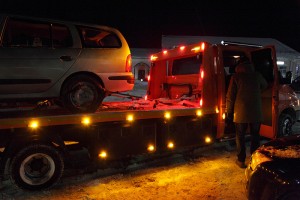 Every day in the United States there are – on average – over 12,000 “roadway incident responses”. Each incident can expose responders to the potential risk of being struck by drivers who are not paying attention to their surroundings.
Every day in the United States there are – on average – over 12,000 “roadway incident responses”. Each incident can expose responders to the potential risk of being struck by drivers who are not paying attention to their surroundings.
- Among causes of law enforcement deaths over a 10-year period, “struck-by vehicle” ranked 4th highest category out of 20 categories.
- Forty-five percent of EMS workers deaths resulted from highway incidents, mostly due to vehicle collisions, with an additional 12% involving personnel being struck by vehicles.
- Up to one quarter of annual line-of-duty firefighter fatalities are attributable to motor vehicle accidents, including struck-by incidents.
- Towing companies lose about 40 to 50 operators annually. In some instances, 75% of the fatalities involved struck-by incidents.
Pennsylvania’s “Steer Clear” law
Pennsylvania previously addressed the need to provide a wider margin of safety for roadway responders with its Steer Clear law which went into effect in September 2006. The law required motorists to move to a lane that is not adjacent to the scene of an emergency response, police stop or a tow truck picking up an abandoned vehicle. If drivers cannot move over because of traffic or other conditions, they must reduce their speed. However, no mention was made of how much of a reduction in speed was required.
“Move Over” Law
Due to a high volume of violations, more specific language and stronger penalties were enacted. Hence “Steer Clear” was rebranded as “Move Over”, revised and signed into law on October 29, 2020.
The duty of a driver under the new law is set forth in Section 3327 of Title 75:
(a) [General rule] Emergency response areas. — When approaching or passing an emergency response area, a person, unless otherwise directed by an emergency service responder, shall:
(1) pass in a lane not adjacent to that of the emergency response area, if possible; or
(2) if passing in a nonadjacent lane is impossible, illegal or unsafe, pass the emergency response area at a speed of no more than 20 miles per hour less than the posted speed limit and reasonable for safely passing the emergency response area.
(a.1) Disabled vehicles. — When approaching or passing a disabled vehicle, a person shall:
- if it is possible to do so, pass in a lane not adjacent to that of the disabled vehicle; or
- if it is impossible, illegal or unsafe to comply with paragraph (1), pass the disabled vehicle at a rate of speed that is no more than 20 miles per hour less than the posted speed limit and reasonable for safely passing the disabled vehicle.
An “emergency response area” is defined as either:
- The area in which emergency service responders render emergency assistance to individuals on or near a roadway or a police officer is conducting a traffic stop or systematic check of vehicles or controlling or directing traffic as long as the emergency vehicle is making use of visual signals; or
- The area in which contractors or employees of a public utility, a municipally owned utility or an electric cooperative provide disaster emergency-related services.
A “disabled vehicle” is defined as “a vehicle that is in a traffic lane or on the side of a traffic lane and is clearly marked with at least two specified markings.”
Penalties
The Move Over law imposes higher fines than the Steer Clear law: $500 for first-time offenders, $1,000 for a second offense, and $2,000 and a 90-day license suspension for a third or subsequent offense. It also doubles fines for several traffic violations when committed in an emergency response area when first responders are present. The new law also provides for a fine of up $10,000 for causing death.
If you’ve been seriously injured as a result of another driver’s negligence, call (570) 829-1111 to speak with one of our experienced Comitz Law attorneys, or email info@comitzlaw.com.


